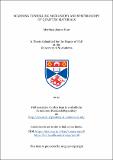Files in this item
Scanning tunnelling microscopy and spectroscopy of quantum materials
Item metadata
| dc.contributor.advisor | Wahl, Peter | |
| dc.contributor.advisor | Stock, Christopher | |
| dc.contributor.author | Neat, Matthew James | |
| dc.coverage.spatial | xxiii, 175 p. | en_US |
| dc.date.accessioned | 2018-03-23T14:55:17Z | |
| dc.date.available | 2018-03-23T14:55:17Z | |
| dc.date.issued | 2018-06-27 | |
| dc.identifier.uri | https://hdl.handle.net/10023/13008 | |
| dc.description.abstract | Scanning tunnelling microscopy and spectroscopy (STM/STS) of heavy fermion materials and superconductors has enabled the high energy and momentum resolution probing of their electronic and many-body interactions. Heavy fermion superconductivity and its links to unconventional pairing mechanisms remains not fully understood; and the potential role for topology in governing the surface properties of these materials is an exciting new topic in condensed matter physics. In this thesis I will present STM/STS investigations into four quantum materials with heavy fermion and/or superconducting properties. In UPt3 the heavy fermion behaviour is investigated, resulting in the visualisation of the Kondo lattice. Signatures of inelastic tunnelling were seen, consistent with known phonon excitations; as well as a small gap-like structure above the Fermi level. No superconducting gap was detected at the surface of UPt3 and quasiparticle interference (QPI) revealed light bands at the Fermi level. The spectroscopy of PdTe2 is then investigated, revealing sharp peaks in conductance consistent with band extrema seen in ARPES; as well as conventional type-II BCS superconductivity. Strong QPI signatures were revealed to be consistent with scattering of quasiparticles from the topological surface states seen in ARPES, with a chiral spin texture dictating the q-space structure of the QPI imaging. The superconductivity at high magnetic eld in FeSe was then investigated, revealing a two-band character gap structure with signi cant anisotropy. The superconducting gap persisted up to 14 T; suggesting that FeSe remains a superconductor up to even higher magnetic elds. Finally QPI measurements on SmB6 were compared to a bulk tight binding model, which demonstrated that the surface band structure and QPI is well described by a bulk model and in particular f-states and their hybridisation. Evidence for topological properties are not obvious but in-gap conduction is seen, therefore providing some metallic surface states of some kind. | en |
| dc.language.iso | en | en_US |
| dc.publisher | University of St Andrews | |
| dc.subject.lcc | QC611.24N4 | |
| dc.title | Scanning tunnelling microscopy and spectroscopy of quantum materials | en_US |
| dc.type | Thesis | en_US |
| dc.contributor.sponsor | Engineering and Physical Sciences Research Council (EPSRC) | en_US |
| dc.type.qualificationlevel | Doctoral | en_US |
| dc.type.qualificationname | PhD Doctor of Philosophy | en_US |
| dc.publisher.institution | The University of St Andrews | en_US |
This item appears in the following Collection(s)
Items in the St Andrews Research Repository are protected by copyright, with all rights reserved, unless otherwise indicated.

